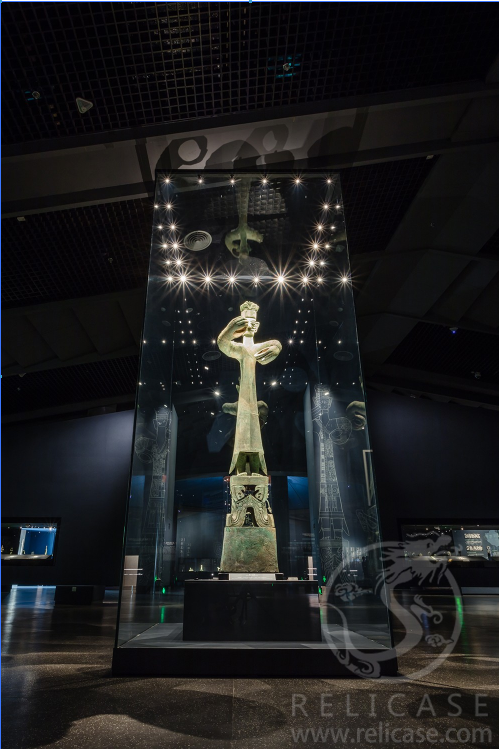Henan Museum is famous for its rich collections of prehistoric relics, bronze vessels from Shang and Zhou period, ceramics and jade wares from several periods. More than 5000 pieces of its collections are rated first class or second class national relics. Among them, 9 national treasures stand out as star exhibits. Relicase was honored to convey perfect protection for those relics with our museum display cases.

Star exhibit No.1
Square ewer with design of lotus and crane
Spring and Autumn Period( 770-476B.C. )
Unearthed at Xinzheng,Henan in 1923
This ewer, excavated in 1923, belonged to the King of the Zheng State . The vivid crane on its top, which is spreading its wings ready for flight contrasts sharply to the traditional over elaborate decorations on its body. It reflects a completely new artistic idea in late Spring and Autumn Period.

Star exhibit No.2
Bronze rectangular Ding with animal mask motif
Shang Dynasty ( 16th century-11st century B.C. )
Unearthed at Zhengzhou,Henan in 1974
This Ding is the earliest large rectangular Ding discovered in China so far. It is of great importance for the study of the social system and casting technique of the Shang Dynasty.

Star exhibit No.3
"Fuhao" Owl-shaped bronze Zun, wine container
Late Shang Dynasty
Unearthed at Anyang,Henan in 1976
The Zun was excavated at the Fuhao tomb of the Yin ruins. Fuhao was the wife of King Wuding of the Shang Dynasty. When her tomb was excavated in 1976, as many as 468 pieces of bronze ware were discovered. They give convincing evidence of the highly developed bronze civilization of the Shang Dynasty.

Star Exhibit No.4
Bronze Jin with cloud design
Spring and Autumn Period ( 770-476B.C. )
Unearthed at Xichuan,Henan in 1978
Jin is a table for wine vessels. Its body has several layers of cloud-shaped relief decorations supported by bronze stalks of various sizes, with twelve dragon-shaped animals climbing around and another twelve staying at the bottom as legs of the Jin. Of all the bronze objects cast by using the lost wax casting technique unearthed in China, this one is the earliest. The exquisite and complex craftsmanship of this Jin reached an amazingly high level.

Star exhibit No.5
The Jiahu Bone Flute
Peiligang Culture(circa 7000--5000BCE)
Unearthed at Jiahu Site, Wuyang, Henan province in 1987
This flute is made from the wing bone of a bird from the crane family. It is shaped like a long pipe, with a series of seven holes drilled in a straight line down one side. It is believed to be the ancestor of China’s wind instruments.

Star exhibit No.6
Mural painting of four animals in clouds
Western Han Dynasty
Unearthed from the tomb of the King Lianggongwang in 1987.
壁画长5.14米,宽3.27米,面积16.8平方米,后经考古专家通过科技手段对壁画进行原样切割移至河南博物院。《四神云气图》位于墓室顶部,中部一条7米长巨龙飞腾,东朱雀,西白虎,四周由怪兽、灵芝及云气纹图案装饰。壁画总面积达30平方米,比敦煌壁画还要早600多年,历史艺术价值极高,是中国目前所见时代最早、画面最大、级别最高、保存最为完整的壁画。

Star exhibit No.7
Iron sword with jade handle
Western Han Dynasty
Unearthed from the tomb of Guo Ji, Sanmenxia, Henan in 1990.
This sword consists of an iron blade and a jade handle. Studies show that the iron blade was even carburized. It is the earliest artificially cast iron object in China so far. The discovery of this sword advances 200 years to the history of China’s artificial irony smelting.

Star exhibit No.8
Gold slip for absolving sin
Tang Dynasty ( A.D.770)
Unearthed at Dengfeng,Henan in 1982
This gold slip for absolving sin was discovered in the northern side of Junji Peak of Mount Songshan in Dengfeng County, Henan Province in 1982. It was given to her entourage by Empress Wu Zetian who was the only female Empire in China as a written message for absolving sin when she visited Mount Songshan in AD 700.

Star exhibit No.9
Sky blue glaze Ru Kiln vase with incised and applied decoration
Northern Song Dynasty
Unearthed at Qingliangsi, Baofeng county, Henan in 1987.
The Ru Kiln ranks the first among the five most famous Imperial kilns, or the official kilns in the Northern Song Dynasty. Each Ru Imperial kiln porcelain is a rare treasure. The Ru kiln porcelains handed down are absolutely rare around the world --- not more than 150 pieces in total. Among which, only five pieces of sky blue ones are registered. This one is the sole sky blue, incised swan-neck vase in the world. It is the sole object acquired by excavation; the most rare in the world; and without equal.
https://www.relicase.com/news-detail-id-356.html










































